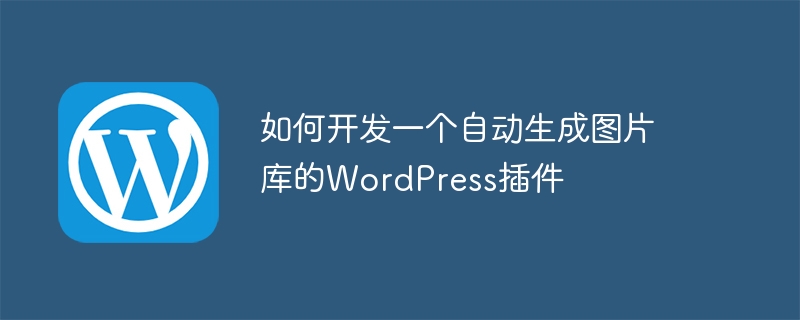

How to develop a WordPress plug-in that automatically generates a picture library
With the development of the mobile Internet, pictures have become a common medium for us to express and transmit information online. In the process of establishing and maintaining a personal blog, we usually need a picture library to manage and display our picture resources. In order to facilitate the use of WordPress blog users, this article will introduce how to develop a WordPress plug-in that automatically generates image libraries, and provide code examples.
First, we need to create the infrastructure of a WordPress plugin. In your WordPress plugin directory, create a new folder and create a plugin master file in it, namedimage-library.php. In the main file, we need to define the basic information and initialization function of the plug-in.
Copy after login
Next, we need to add a custom database table to store image information. In order to simplify the development process, we use the wpdb class that comes with WordPress to perform database operations.
// 创建数据库表 function image_library_create_table() { global $wpdb; $table_name = $wpdb->prefix . 'image_library'; // 添加表前缀 $charset_collate = $wpdb->get_charset_collate(); $sql = "CREATE TABLE $table_name ( id mediumint(9) NOT NULL AUTO_INCREMENT, title text NOT NULL, file_url text NOT NULL, PRIMARY KEY (id) ) $charset_collate;"; require_once( ABSPATH . 'wp-admin/includes/upgrade.php' ); dbDelta( $sql ); // 创建表 } register_activation_hook( __FILE__, 'image_library_create_table' );
Next, we need to add a menu item in the WordPress backend so that users can enter the image library management interface. You can use theadd_menu_pagefunction to achieve this function.
// 添加菜单项 function image_library_add_menu() { add_menu_page( '图片库', '图片库', 'manage_options', 'image-library', 'image_library_menu', 'dashicons-format-gallery', 25 ); } add_action('admin_menu', 'image_library_add_menu');
Then, we need to create the interface corresponding to the menu. In this interface, we can display a list of all images and provide functions for uploading and deleting images.
// 图片库管理界面 function image_library_menu() { if (!current_user_can('manage_options')) { wp_die(__('您没有权限访问该页面。')); } // 添加上传图片逻辑 if (isset($_POST['submit'])) { $title = sanitize_text_field($_POST['title']); $file_url = sanitize_text_field($_POST['file_url']); global $wpdb; $table_name = $wpdb->prefix . 'image_library'; $wpdb->insert($table_name, array('title' => $title, 'file_url' => $file_url)); echo '图片上传成功!
'; } // 添加删除图片逻辑 if (isset($_GET['delete']) && isset($_GET['nonce'])) { if (!wp_verify_nonce($_GET['nonce'], 'delete_image')) { wp_die(__('非法请求。')); } $id = intval($_GET['delete']); global $wpdb; $table_name = $wpdb->prefix . 'image_library'; $wpdb->delete($table_name, array('id' => $id)); echo '图片删除成功!
'; } // 展示图片列表 global $wpdb; $table_name = $wpdb->prefix . 'image_library'; $images = $wpdb->get_results("SELECT * FROM $table_name"); echo ''; echo '图片库管理
'; echo ''; echo ''; }
Finally, we need to add a shortcode to the image gallery to embed images in posts or pages.
// 图片库短代码 function image_library_shortcode($atts) { ob_start(); global $wpdb; $table_name = $wpdb->prefix . 'image_library'; $images = $wpdb->get_results("SELECT * FROM $table_name"); echo ''; foreach ($images as $image) { echo ''; echo '' . $image->title . '
'; echo ' file_url . '">'; echo ''; } echo ''; return ob_get_clean(); } add_shortcode('image-library', 'image_library_shortcode');
file_url . '">'; echo ''; } echo ''; return ob_get_clean(); } add_shortcode('image-library', 'image_library_shortcode');
Now, we have completed the development of the WordPress plug-in that automatically generates image libraries. You can save the above code into the main plugin fileimage-library.phpand place the file in your WordPress plugin directory. Then, activate the plug-in on the WordPress backend plug-in management page.
When developing plug-ins, pay attention to following WordPress development specifications as much as possible, and provide users with a friendly interface and operating experience. I hope this article can help you develop WordPress plug-ins!
The above is the detailed content of How to develop a WordPress plugin that automatically generates image galleries. For more information, please follow other related articles on the PHP Chinese website!
 fakepath path solution
fakepath path solution Java rounding method
Java rounding method The role of float() function in python
The role of float() function in python There is an extra blank page in Word and I cannot delete it.
There is an extra blank page in Word and I cannot delete it. How to enter the d drive with cmd
How to enter the d drive with cmd Intouch report production method
Intouch report production method Usage of items in python
Usage of items in python Solution to computer black screen prompt missing operating system
Solution to computer black screen prompt missing operating system



